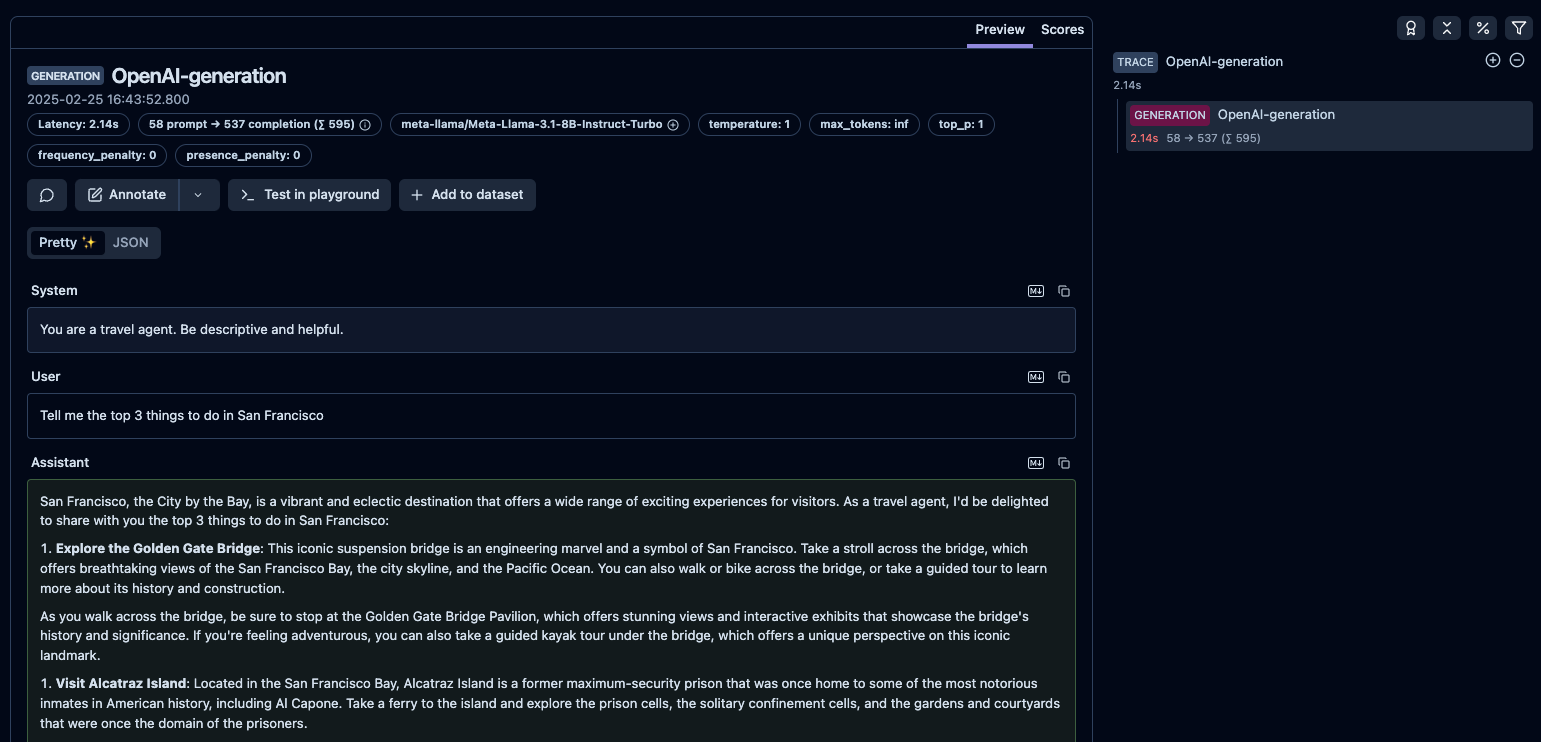Observability for Together.ai with Langfuse
This guide shows you how to integrate Together.ai with Langfuse. Together’s API endpoints for chat, language and code, images, and embeddings are fully compatible with OpenAI’s API. This allows us to use the Langfuse OpenAI drop-in replacement to trace all parts of your application.
What is Together.ai? Together.ai empowers developers and researchers to train, fine-tune, and deploy generative AI models, offering access to over 100 open-source models on both serverless and dedicated instances. The platform emphasizes decentralized cloud services, enabling organizations of all sizes to customize AI solutions using their own data.
What is Langfuse? Langfuse is an open source LLM engineering platform that helps teams trace API calls, monitor performance, and debug issues in their AI applications.
Step 1: Install Dependencies
Make sure you have installed the necessary Python packages:
%pip install openai langfuseStep 2: Set Up Environment Variables
import os
# Get keys for your project from the project settings page
# https://cloud.langfuse.com
os.environ["LANGFUSE_PUBLIC_KEY"] = "pk-lf-..."
os.environ["LANGFUSE_SECRET_KEY"] = "sk-lf-..."
os.environ["LANGFUSE_BASE_URL"] = "https://cloud.langfuse.com" # 🇪🇺 EU region
# os.environ["LANGFUSE_BASE_URL"] = "https://us.cloud.langfuse.com" # 🇺🇸 US region
# Get your Together.ai API key from the project settings page
os.environ["TOGETHER_API_KEY"] = "..."Step 3: Langfuse OpenAI drop-in Replacement
In this step we use the native OpenAI drop-in replacement by importing from langfuse.openai import openai.
To start using Together with OpenAI’s client libraries, pass in your Together API key to the api_key option, and change the base_url to https://api.together.xyz/v1:
# instead of import openai:
from langfuse.openai import openai
client = openai.OpenAI(
api_key=os.environ.get("TOGETHER_API_KEY"),
base_url="https://api.together.xyz/v1",
)Note: The OpenAI drop-in replacement is fully compatible with the Low-Level Langfuse Python SDKs and @observe() decorator to trace all parts of your application.
Step 4: Run An Example
The following cell demonstrates how to call Together.ai’s chat model using the traced OpenAI client. All API calls will be automatically traced by Langfuse.
client = openai.OpenAI(
api_key=os.environ.get("TOGETHER_API_KEY"),
base_url="https://api.together.xyz/v1",
)
response = client.chat.completions.create(
model="meta-llama/Meta-Llama-3.1-8B-Instruct-Turbo",
messages=[
{"role": "system", "content": "You are a travel agent. Be descriptive and helpful."},
{"role": "user", "content": "Tell me the top 3 things to do in San Francisco"},
]
)
print(response.choices[0].message.content)Step 5: See Traces in Langfuse
After running the example model call, you can see the traces in Langfuse. You will see detailed information about your Together.ai API calls, including:
- Request parameters (model, messages, temperature, etc.)
- Response content
- Token usage statistics
- Latency metrics

Interoperability with the Python SDK
You can use this integration together with the Langfuse Python SDK to add additional attributes to the trace.
The @observe() decorator provides a convenient way to automatically wrap your instrumented code and add additional attributes to the trace.
from langfuse import observe, propagate_attributes, get_client
langfuse = get_client()
@observe()
def my_llm_pipeline(input):
# Add additional attributes (user_id, session_id, metadata, version, tags) to all spans created within this execution scope
with propagate_attributes(
user_id="user_123",
session_id="session_abc",
tags=["agent", "my-trace"],
metadata={"email": "user@langfuse.com"},
version="1.0.0"
):
# YOUR APPLICATION CODE HERE
result = call_llm(input)
# Update the trace input and output
langfuse.update_current_trace(
input=input,
output=result,
)
return resultLearn more about using the Decorator in the Python SDK docs.
Next Steps
Once you have instrumented your code, you can manage, evaluate and debug your application: